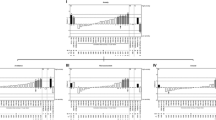Summary
The simplified triple-test cross (sTTC) is a mating design that, because of its economic use of the experimental material as compared with other designs, seems very attractive. In theory, its power is almost equal to that of more elaborate designs such as the diallel cross. To evaluate the merits of both designs in a genetic analysis of mouse behavior, the results of a previous replicated 4×4 diallel cross (Crusio and van Abeelen 1986) were reanalyzed as a sTTC. We found that, at least with the fairly low number of strains employed, the sTTC analysis is clearly inferior to the diallel cross. This finding, in combination with some theoretical considerations, leads to the conclusion that the sTTC design is not a very useful one for such studies.
Similar content being viewed by others
References
Crusio WE, Kerbusch JML, Abeelen JHF van (1984) The replicated diallel cross: A generalized method of analysis. Behav Genet 14:81–104
Crusio WE, Abeelen JHF van (1986) The genetic architecture of behavioural responses to novelty in mice. Heredity 56:55–63
Fulker DW (1972) Applications of a simplified triple-test cross. Behav Genet 2:185–198
Hayman BI (1954) The analysis of variance of diallel tables. Biometrics 10:235–244
Hewitt JK (1980) A note on the test for the direction of dominance in the triple test cross in the presence of genotype x environment interaction. Heredity 45:293–295
Jinks JL, Perkins JM, Breese EL (1969) A general method of detecting additive, dominance and epistatic variation for metrical traits. 2. Application to inbred lines. Heredity 24:45–57
Kearsey MJ, Jinks JL (1968) A general method of detecting additive, dominance and epistatic variation for metrical traits. 1. Theory. Heredity 23:403–409
Mather K, Jinks JL (1982) Biometrical genetics, 3rd edn. Chapman and Hall, London
Sachs L (1974) Angewandte Statistik, 4. Aufl. Springer, Berlin
Sing M, Singh RK (1984) A comparison of different methods of half-diallel analysis. Theor Appl Genet 67:323–326
Singh O, Paroda RS (1984) A comparison of different diallel analyses. Theor Appl Genet 67:541–545
Virk DS, Jinks JL (1977) The consequences of using inadequate testers in the simplified triple test-cross. Heredity 38:237–251
Author information
Authors and Affiliations
Additional information
Communicated by A. Robertson
Rights and permissions
About this article
Cite this article
Crusio, W.E., van Abeelen, J.H.F. A comparison between the full diallel cross and the simplified triple-test cross. Theoret. Appl. Genetics 73, 27–30 (1986). https://doi.org/10.1007/BF00273714
Received:
Accepted:
Issue Date:
DOI: https://doi.org/10.1007/BF00273714




